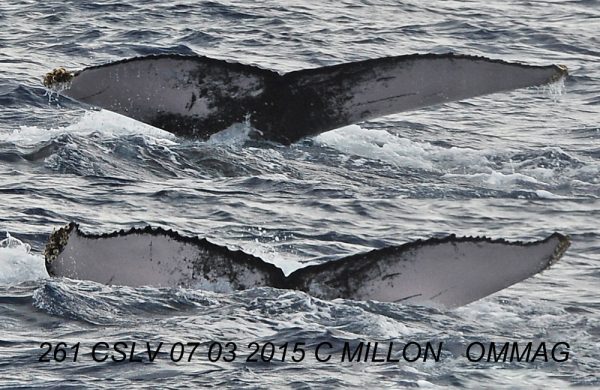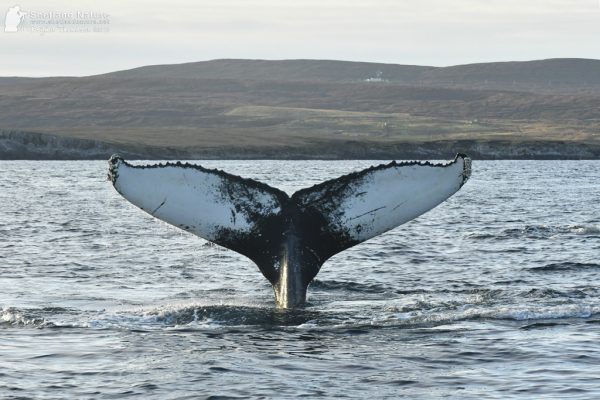A Humpback ID match UK first: Caribbean/Shetland Islands
Posted by Brydon Thomason on Wednesday 15th February 2017 | Sea Mammals in Shetland
I find it quite incredible to write about yet another chapter in the story of Humpback Whales that spent five weeks this winter between Yell, Fetlar and Unst. Each part of the story to unfold has certainly been worth sharing and now, none more so than this one. It is thanks to a very exciting, encouraging and gratifying international collaboration we discovered that for the first time ever a Humpback Whale has been recorded in British waters from the breeding grounds off Guadeloupe, in the southeast Caribbean!
Back in early December I was able to capture several close-up images of at least two of the five whales tale flukes. In addition to the thrill in nailing images of Humpbacks I would never before have thought possible in Shetland, I could see that potentially for the first time ever in Shetland or even UK waters, good enough images of the detail needed for ID work may be possible. As many who have seen or worked on Humpbacks in UK waters, getting good close up and detailed images of tail flukes are rarely possible. I put some ‘feelers out’ by email and via social media with a couple of images, asking for any help and also to The North Norwegian Humpback Whale Catalogue (NNHWC).
Far from being anything near an expert on Humpback Whales I hoped that the Norwegian wintering populations might make most sense however the NNHWC, as helpful as they were did not find a match. It was on Twitter however that Dan Lettice recommended Pádraig Whooley of The Irish Whale and Dolphin Group (http://www.iwdg.ie/). This was where it really began to pick up pace. Pádraig was totally fantastic, a wealth of knowledge about Humpbacks and their movements, especially through their work off Ireland but also his tireless enthusiasm and passion. Straight away he took on to do what he could with their humpback whale photo ID database but more so recommended I send the images to The North Atlantic Humpback Whale Catalogue (NAHWC) at the College of the Atlantic, Bar Harbor, Maine, USA. (http://www.coa.edu/allied-whale/research/)
As had been the case from Ireland and Norway, they were thrilled to receive images and offer help. From the offset I had cc’d each organisation into the email sent to Maine and so the collaboration began. Each and every one of us was as amazed as the other when word came back- they had found a match! This same whale had been photographed on the breeding grounds off Guadeloupe in the Caribbean!! The first ever match from British waters to their breeding grounds!
It was Frederick Wenzel (NAHWC) who picked out the match from their database, the largest of its kind with >9,000 individual tail fluke images (spanning from 1976 to 2016) maintained at Allied Whale; by Judy Allen, Peter Stevick and Tom Fernald.
Laurent Bouveret, who directs the OMMAG Observatoire des Mammifères Marins de l’Archipel Guadeloupéen (OMMAG) (http://ommag.info/) project, which includes hundreds of photos of whales from the eastern Caribbean was thrilled with the news; “Fred and Tom you made my day!! In attachment, our picture taken by Whale watcher Cedric Millon from Guadeloupe Evasion Découverte company, the 7th March 2015, leeward side of Guadeloupe Main Island N 16.2161111 W -61.814166, an adult accompanied with another adult”.
How amazing was that for the same whale to be photographed here in Shetland approximately 4,500 miles away! Interestingly on the day of the encounter, this whale was again accompanied with another adult. Although I did nail ID images of its tail flukes however, there have been no further matches. I couldn’t help but wonder if it could be the same two whales still together.
Padraig’s response and his enthusiastic ‘sportingly competitive’ banter especially amused me; “Crikey… how’s that for beginners luck? We’ve been sending Irish humpbacks for years to the NAHWC catalogue without a single match to a breeding ground, and our friends in Shetland manage a match on their 1st share- Wonderful news!”
“This really sets the cat among the pigeons as we’ve had something of a working hypothesis that our Irish humpbacks are more likely to be from the Cape Verdes on this side of the Atlantic. This is a great result and an important contribution to our understanding of these iconic animals”
Although this is the first ever match from UK or Ireland to a breeding ground there has been many photographic matches from Norwegian waters to the Cape Verde Islands as well as the Caribbean. At this time, the Irish humpback collection has produced matches to the Netherlands, Gibraltar, Iceland and Norway.
Having had the sharp eyes to pick out the match Frederick Wenzel has conducted photo-ID matching of right whale, blue whales and humpbacks for many years. “I voluntarily curate the Cape Verde Island humpback catalogue, and work closely with Fredrik, Laurent, Padraig and many others in this international collaboration … Wenzel currently works for the US govt. at NOAA, National Marine Fisheries Service, Northeast Fisheries Science Center, Woods Hole, Massachusetts, USA on large whales, pinnipeds, foraging ecology and bycatch for small cetaceans and seals.
“At times, I can say I have a photographic memory…I recognize flukes. I have seen before…however, in the same breath…I may not remember someone’s name, but I recognize their face”.
In Norway (NNHWC), Fredrik Broms has produced some interesting matches to Iceland, Cape Verde Islands, Guadeloupe and the Dominican Republic. The team at NNHWC are currently working on a very interesting project having satellite-tagged ten humpbacks off Tromsø this winter. You can find out more about this at https://whaletracking.uit.no/.
This unprecedented ID match in itself is of course significant and will hopefully perhaps help to grow our understanding of these wonderful creatures and their movements. For me personally I was just lucky to be in the right place at the right time to get a shot good enough images to assess by the researchers and organisations. It is however their ongoing commitment, research and perhaps above all collaboration that makes discoveries such as these possible.
Something that I noticed straight away when I started to look to where to send images was that there isn’t actually a UK catalogue/project. Granted of course there are some great organisations doing fantastic and very important work such as Sea Watch Foundation but no one is yet to set up an actual ID catalogue/database. This appears to be something that the international projects already working together are aware of and can see the need for.
But of course a reason for this may well be that as mentioned above there are very few good enough images that exist in British waters but as Pádraig pointed out, it only takes one image to start and already we have a result; “It will be great If interested groups could come together to document these animals in Scottish waters and a good way to pull this together is by setting up a Scottish humpback whale catalogue”.
With the quality of camera equipment used by so many people now and indeed social media there has never been a better time for this to start and as I found out with images from our encounters, anyone can contribute and make a difference. With such a fantastic and growing success story for Humpback Whales it seems quite likely we will have opportunity to enjoy them and hopefully help further our understanding of their movements.
A huge thank you to the following individuals and organisations for their help and collaboration; Pádraig Whooley of The Irish Whale and Dolphin Group; Frederik Wenzel, Thomas Fernald, Judy Allen and Peter Stevick of the NAHWC; Laurent Bouveret of the OMMAG; Frederick Broms of NNHWC and Cedric Millon from Guadeloupe Evasion Découverte company OMMAG https://www.facebook.com/ommag971/ and http://www.guadeloupeevasiondecouverte.com/
View previous posts:



